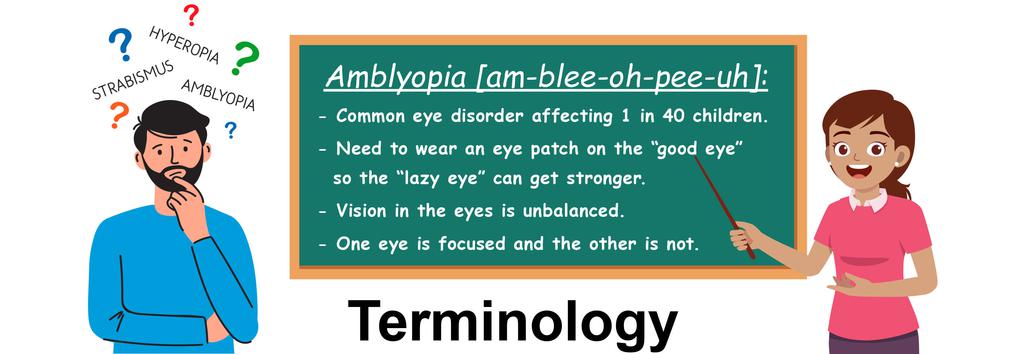 When parents are told that their child needs to wear an eye patch many become dazed and confused. It is unexpected and the medical terms used to describe their child's diagnosis are difficult to pronounce and spell. The eye doctor might project an intimidating, scary tone which can frighten the parents but their intent is to help parents understand the severity of the eye problem. Some parents have left the doctor's office in tears unsure of what just happened. The first thing to do is educate yourself. Call the doctor/nurse back when you get home and quiz them on confusing words, do your research and then ask more questions. We have listed many of the terms here. |
|
Amblyopia is a common eye disorder affecting one out of every 40 children. This condition is sometimes referred to as "lazy eye". The vision in the eyes is unbalanced, one eye is focused and the other is not, thus the term "lazy eye". The brain prefers to use the eye that is focused so that part of the brain develops normally. Since the lazy eye is not working to it's full potential; the brain area connected to the lazy eye becomes underdeveloped. Hyperopia (Farsightedness) In this condition, the eyeball is too short for the normal focusing power of the eye. In children, the lens in the eye accommodates for this error and provides clear vision for distance and usually near viewing, but with considerable effort that often causes fatigue and sometimes crossed eyes (strabismus). |
Astigmatism results primarily from an irregular shape of the front surface of the cornea, the transparent "window" at the front of the eye. Persons with astigmatism typically see vertical lines more clearly than horizontal ones, and sometimes the reverse. Myopia (Nearsightedness) Retinopathy of Prematurity Soon after birth, some premature infants develop changes in the blood vessels of the eye's retina that can permanently impair vision. |
Cataract- A cataract is a clouding of the lens in the eye that affects vision. Most cataracts are related to aging. Cataracts are very common in older people. By age 80, more than half of all Americans either have a cataract or have had cataract surgery. A cataract can occur in either or both eyes. Strabismus is a deviation of the eyes. The term is used to describe eyes that are not straight or properly aligned. The misalignment results from the failure of the eye muscles to work together. One eye, or sometimes both, may turn in (crossed eyes), turn out (wall eyes), turn up or turn down. Sometimes more than one of the 'turns' are present. |




